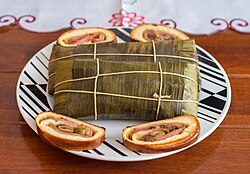 Hallaca and pan de jamón | |
| Alternative names | Ayaca, hayaca, guanimo, tamal, guanime |
|---|---|
| Type | Dumpling |
| Region or state | Latin America |
| Main ingredients | cornmeal dough or cassava dough, meat (beef, pork, chicken), raisins, capers, olives |
| Variations | Pasteles, alcapurrias |
Hallaca (Spanish pronunciation: [aˈʎaka], [aˈʝaka][1]) is a traditional Venezuelan dish. Its origin is indigenous, but raisins, capers, olives, and sometimes bits of bacon were added in the 16th Century and after by settlers from the Iberian peninsula. Hallaca consists of corn dough stuffed with a stew of beef, pork, or chicken and other ingredients such as raisins, capers, and olives, fresh onion rings, red and green bell pepper slices. There are vegetarian hallacas, made with black beans or tofu.[2] Hallacas are folded in plantain leaves, tied with strings, and boiled. The dish is traditionally served during the Christmas season and has several regional variants. It has been described as a national dish of Venezuela. Some speculate it originated from the Orinoquia.[1] Characteristic of the hallaca is the delicate corn dough made with consommé or broth, and lard colored with annatto. Hallacas are also commonly eaten in eastern Cuba,[3][4] Trinidad where it is called pastelle,[5] and parts of Colombia, Ecuador, Aruba, and Curaçao.
- ^ a b Kijac, M.B. (2003). The South American Table: The Flavor and Soul of Authentic Home Cooking from Patagonia to Rio de Janeiro, with 450 Recipes. NYM Series. Harvard Common Press. p. 84. ISBN 978-1-55832-249-3. Retrieved 5 November 2016.
- ^ Albala, K. (2011). Food Cultures of the World Encyclopedia. Food Cultures of the World Encyclopedia. Greenwood. p. 1–PA102. ISBN 978-0-313-37626-9. Retrieved 5 November 2016.
- ^ Garth, Hanna 2013 Food and Identity in the Caribbean. London: Bloomsbury.
- ^ Cuza, Alejandro (15 November 2017). Cuban Spanish Dialectology: Variation, Contact, and Change. ISBN 9781626165113.
- ^ "Pastelles A Caribbean Christmas Tradition". Retrieved 21 December 2020.